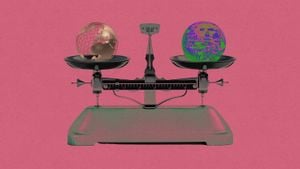NASA astronauts Butch Wilmore and Sunita Williams are stuck aboard the International Space Station (ISS) due to unexpected delays with the Boeing Starliner spacecraft, which was supposed to bring them home. This situation has turned what was intended to be an eight-day mission, beginning on June 5, 2024, well beyond two months with no definite return date yet established.
Initially excited for their relatively short stint among the stars, the astronauts have expressed their willingness to remain optimistic. On July 10, Williams stated they were enjoying the experience, saying it "feels good to float around," and Wilmore expressed confidence about Starliner ensuring their safe return.
But the situation took a turn for the worse as the Starliner encountered significant technical issues, including multiple helium leaks and thruster failures. These complications led NASA to delay any planned return, leaving the astronauts with no immediate solution.
Wilmore, who is currently making do with sleeping arrangements, has been sleeping on the floor of Kibo, the Japanese Space Agency's module, using only his sleeping bag. Williams occupies the Crew Alternate Sleep Accommodation (CASA), sharing space with another astronaut as the station's quarters were already at capacity when they arrived.
Life aboard the ISS has become less about conducting glamorous scientific experiments and more about picking up odd jobs to help fellow crew members. The duo has been assisting with various maintenance chores, including the unglamorous task of repairing the urine processing system within the station, which shows the hands-on reality of living in space.
The astronauts had packed only a limited assortment of clothing suitable for what they anticipated would be their brief trip. While their supplies have dwindled over this extended period, the astronauts received fresh clothing from the last Northrop Grumman resupply mission.
The delay has triggered conversations at NASA about alternative options for their return. If Boeing cannot rectify Starliner's issues, there is potential for both astronauts to be brought back home using SpaceX's Crew Dragon capable of departing for Earth as early as September.
NASA has indicated, though, the timeline for this could stretch as far as February 2025, extending their stay to nearly eight months, which is far longer than planned. This lengthens their time away from home, impacting not only the astronauts’ work but their families as well.
NASA officials are treading carefully with their decisions, mindful of past tragedies like the Columbia and Challenger disasters. Chief of Safety and Mission Assurance at NASA, Russ DeLoach, highlighted the importance of cautious decision-making, emphasizing the need to have all possible safety contingencies figured out before proceeding.
Despite the unforeseen duration of the mission, both Wilmore and Williams have remained dedicated to their work and duties aboard the ISS. Chief astronaut Joe Acaba remarked on their steady professionalism, affirming, "They knew this mission might not be perfect," and continue to adapt as circumstances change.
Meanwhile, concerns have been raised about the health impacts of prolonged stays in microgravity. The astronauts are subject to increased radiation exposure with each passing day, posing risks for future medical issues.
An immediate worry lies with the condition of the Starliner. Wilmore and Williams have been kept informed on the technical difficulties, and NASA has been running tests to ascertain the spacecraft's capacity to safely bring them back to Earth.
Still, the astronauts seem to have maintained positive spirits throughout this ordeal. Reports indicate they are acclimatising to their extended timeframe with humor and camaraderie, making the best out of a complicated scenario.
Although the immediate prospect of home seems increasingly distant, discussions within NASA aim to tackle the challenges and present their options transparently. Hope remains for the astronauts, as they adjust daily to the realities of living and working hundreds of miles above the Earth.
The saga of Wilmore and Williams not only shines light on the issues surrounding space travel but also raises questions about mission preparedness and the inherent unpredictability of outer space operations.
With so many factors at play, focusing on their well-being is front and center for NASA. The agency's overarching goal is to wallpaper guidelines emphasizing safety and careful management of all upcoming missions moving forward.
Wilmore and Williams' resilience is under the spotlight as they tackle life aboard the ISS under such circumstances. Their experiences will surely inform how future missions are executed, particularly those involving complex spacecraft like the Boeing Starliner.
Each day they remain on the space station provides learning opportunities for NASA to improve operational efficiencies. Crucially, both astronauts have remained dedicated to their role even amid uncertainties, showcasing excellence and professionalism regardless of the circumstances.
Hoping for their safe return, families and friends of Wilmore and Williams await eagerly, glancing at each NASA announcement for updates. Even so, inside the ISS teams continue to collaborate, conduct research, and promote awareness of how to deal with space travel's unexpected challenges.
One thing is certain: this experience will only deepen the rich history of space exploration NASA fosters and inspire future generations of aspiring astronauts. Their continued dedication not only serves humanity's quest for knowledge but also reinforces the need for careful planning and preparedness as we take steps exploring the cosmos.



